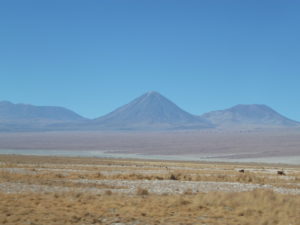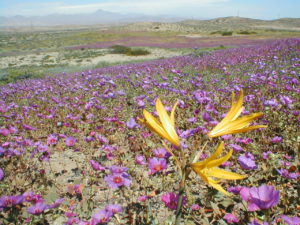It is one of the driest places on earth. Average rainfall is 0.5 inches per year; some areas have no recorded rainfall—ever. But when it does rain, as it did leading up to August 23, 2017, watch out! The desert blooms!
The Atacama Desert in Chile lies along the northwestern edge of the country, a thin line stretching for more than 600 miles, squeezed between the Pacific Ocean and the foot of the Andes mountains. It is a high, cool desert, at an elevation of nearly 8,000 feet and with daytime temperatures only in the high 60s, Fahrenheit.

Even in its usual dry state, it is starkly beautiful. Some areas are painted by a variety of mineral deposits—cobalt, gypsum, lamprophyre. At sunset, the ringing mountains are bathed in orange and yellow. At night, the lack of water vapor in the air and the absence of human settlements bring the sky to life. So vivid is the night sky that the European Southern Observatory maintains two facilities in the area.
And every so often, at intervals of 5-7 years, a drenching rainfall produces what locals call the “desierto florido” or “flowering desert.” That unusual rainfall occurred in early August, 2017, leading to the bloom centered on August 23. The desert blooms as dormant seeds of more than 200 flowering plants burst from the soil. The normally barren landscape is then carpeted in millions of colorful flowers, white, yellow, blue, purple. Although individual flowers may last for only a few days, the different germination rates among species means the phenomenon as a whole lasts for several weeks.

Most of us who love nature know that the desert teems with life. Plants and animals have adapted to the harsh conditions, finding ways to harvest and retain water or being active only at night. A hike through the Sonoran Desert of Arizona reveals abundant life from massive cacti to scurrying insects.
But the massive bloom of Atacama is an especially rare and beautiful reminder that we must be humble about our understanding of nature. What we experience through human eyes on occasional forays into a desert is the equivalent of the small part of the iceberg that lies above the water’s surface. What we don’t see or experience is the massive storehouse of life that hides from our casual understanding or observation.
One of my pet peeves is the environmentalist’s claim that nature is fragile. Nonsense. Nature isn’t fragile or weak or on the brink of destruction. Nature is strong, resilient, dismissive of human attempts to corrupt it. Yes, nature might not produce what we think is scenic or valuable at our command or on our schedule, but what nature produces of its own choosing is both mighty and awesome.
Sometimes the awe comes from the fearsome and immediate forces of a lightning strike or tornado. Sometimes it comes from the slow, relentless forces of a drought or insect invasion.
But sometimes the awe comes from a desert floor awash in colorful blooms that we never knew were possible. Look at nature with open eyes and an open mind—and be awed.
References:
BBC News. Chile’s Atacama desert: World’s driest place in bloom after surprise rain. 23 August 2017. Available at: https://www.bbc.com/news/world-latin-america-41021774. Accessed June 27, 2018.
Encyclopedia Britannica. Atacama Desert. Available at: https://www.britannica.com/place/Atacama-Desert. Accessed June 27, 2018.
Gibbons, Sarah. 2017. See One of Earth’s Driest Places Experience Rare Flower Boom. National Georgaphic News, August 30, 2017. Available at: https://news.nationalgeographic.com/2017/08/chile-atacama-desert-wildflower-super-bloom-video-spd/. Accessed June 27, 2018.
Leadbeater, Chris. Exploring Chile’s Atacama Desert. National Georgraphic Travel. Available at: https://www.nationalgeographic.com/travel/destinations/south-america/chile/explore-chile-atacama-desert-stargazing/. Accessed June 27, 2018.
